Iron ore from Swedish producer LKAB is of unusual quality. It is very pure, fostering highly efficient steel production that minimizes greenhouse gas emissions from the mine to the final production of steel, an independent analysis shows.
For LKAB, a move toward sustainable steel production is a competitive advantage.
“This gives us a head start on others”, says Stefan Savonen, Vice President for Energy and Climate at LKAB.
LKAB commissioned a study to track carbon emissions at every step of steel production. An analysis made by Ecofys, found that steel made with iron ore pellets from LKAB leads to 14% less direct carbon dioxide emissions than average European primary steel,. The reason is that LKAB mines magnetite iron ore, an unusually pure variety, which requires far less energy to transform it into steel than does the far less efficient hematite iron ore.
“The advantage of the pure magnetite iron we have is that it does not require as great an external energy supply during pellet production as hematite”, Savonen said.
In addition to the value chain analysis, LKAB commissioned a carbon footprint study which is verified by SP Technical Research Institute of Sweden. It was commissioned because of LKAB’s interest to chart the total climate impact of its products, particularly important after the Paris agreement on climate change in 2016.
Estimating the carbon footprint of various varieties of iron ore products, which are produced in small grape-sized balls known as “pellets”, turned out to be major challenge but was important in order to be transparent. Experts had to trace greenhouse gas emissions at each step of production. The carbon footprint result was positive for LKAB, which is the first major producer of iron ore to examine the entire chain of emissions in steel production.
“Energy consumption and emissions of carbon dioxide from the manufacture of our pellets are among the lowest in the iron ore sector. LKAB has one of the world’s most energy efficient pelletising plants in the world and strives to become completely CO2 neutral by 2045”, says Savonen.”










